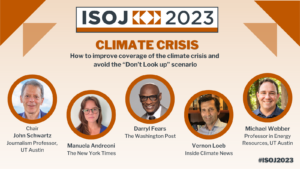March 10, 2023 | Environmental Journalism, ISOJ2023, Science and Health Journalism
Climate crisis: ISOJ 2023 panel to explore reporting on the biggest story of our time
It’s a story so big that investigative sites, networks and newsroom beats have been formed to cover it. Reporting on the global climate crisis requires all hands on deck, and that includes journalists.
During the 24th International Symposium on Online Journalism (ISOJ), speakers will consider reporting on the climate crisis and its effects, including the spread of disinformation around the topic.
“How to improve the coverage of the climate crisis and avoid the ‘Don’t Look up’ scenario” will take place on Saturday, April 15, 2023, at 9:45 a.m. both virtually and at the University of Texas at Austin. (‘Don’t Look up’ is a reference to the 2021 satiric movie directed by Adam McKay that shows the struggle of two astronomers to convince journalists and the public in general about an approaching comet that will destroy the Earth.)

“As the independent climate journalist Emily Atkin has said, ‘right now, everyone should be a climate reporter. And if you’re not a climate reporter right now, you will be,’” science journalist and panel moderator John Schwartz noted.
“Climate change is now part of every beat and every bureau’s coverage around the world. Even if you’re not a climate specialist, you need to know the basics — and be able to recognize the incredible amount of disinformation out there — to take on the challenge of this growing beat,” he continued.
Schwartz, a professor of practice at the School of Journalism and Media at UT Austin, will be joined on the panel by:
- Manuela Andreoni, Brazil-based climate reporter for The New York Times
- Darryl Fears, environmental justice reporter for The Washington Post
- Vernon Loeb, executive editor of Inside Climate News
- Michael Webber, Josey Centennial Professor in Energy Resources at UT Austin
The panel features a combination of award-winning journalists covering the climate beat and a scientist and communicator who Schwartz said can help reporters avoid errors.
“Journalists are great at the quick study. But we depend on those with deeper expertise to help us get things right; true experts help us avoid the mistakes of the unknown unknowns,” he said. “At the same time, many people with scientific and technical expertise have become outstanding science communicators, and journalists have a lot to learn from them.”
Reporting on the climate crisis is one thing, but getting readers and viewers to pay attention is another.
“To interest readers in the climate crisis, we have to reimagine how we tell stories. An invisible threat presents a storytelling challenge that’s far different from anything media have covered, and old models don’t work,” Darryl Fears said. “Every coverage team in the newsroom should be aware of how climate impacts what they cover and they should point it out whenever possible.”
For Fears, it’s important to show the problem, as opposed to just telling news consumers. This means large publications pairing writers with graphic artists to illustrate what the science says, or incorporating the tool of photography to convey urgency.
“Finally, reporting needs to find alternative voices to those who say the current climate goal of limiting warming to 2.0 degrees C is reachable, because far too many academics and scientists disagree that this is the case,” he said. “In fact, we should find the detractors and tell their story.”
Manuela Andreoni, who authors the Climate Forward newsletter for The New York Times, said her project has taught her the importance of listening and understanding questions, concerns and experiences.
“Doing this creates a lot of opportunities for us to draw direct lines between the issues that are close to people’s hearts and the most consequential aspects of the climate crisis,” she said. “People are scared and tired, but they still care.”
ISOJ is an annual conference of journalists, media executives and scholars to discuss the impact of the digital revolution on journalism. It will take place this year on April 14 and 15, both virtually and in person at UT Austin. Registration is open.

